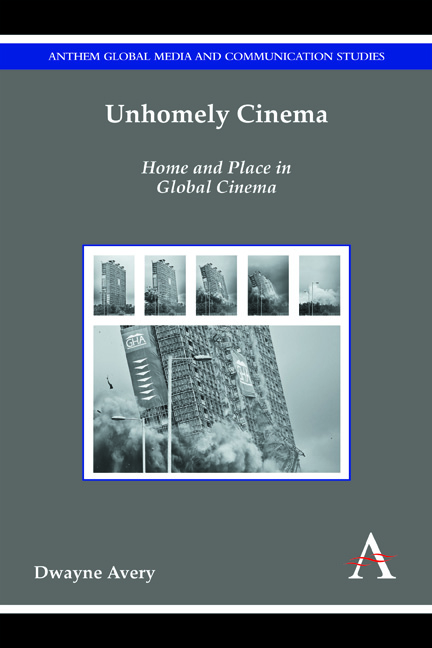Book contents
- Frontmatter
- Contents
- Introduction Unhomely Cinema
- Chapter 1 An Unhomely Theory
- Chapter 2 The Decline of the Family: Home and Nation in Krzysztof Kieślowski's The Decalogue
- Chapter 3 The Future Is behind You: Global Gentrification and the Unhomely Nature of Discarded Places
- Chapter 4 No Place to Call Home: Work and Home in Paul Thomas Anderson's Punch Drunk Love and Jason Reitman's Up in the Air
- Chapter 5 The Terrible Lightness of Being Mobile: Cell Phone and the Dislocation of Home
- Chapter 6 Unhomely Revolt in Laurent Cantet's Time Out
- Conclusion
- References
- INDEX
- Frontmatter
- Contents
- Introduction Unhomely Cinema
- Chapter 1 An Unhomely Theory
- Chapter 2 The Decline of the Family: Home and Nation in Krzysztof Kieślowski's The Decalogue
- Chapter 3 The Future Is behind You: Global Gentrification and the Unhomely Nature of Discarded Places
- Chapter 4 No Place to Call Home: Work and Home in Paul Thomas Anderson's Punch Drunk Love and Jason Reitman's Up in the Air
- Chapter 5 The Terrible Lightness of Being Mobile: Cell Phone and the Dislocation of Home
- Chapter 6 Unhomely Revolt in Laurent Cantet's Time Out
- Conclusion
- References
- INDEX
Summary
A Look Back or an Unhomely Return
Set in a futuristic Los Angeles, Neill Blomkamp's second feature film, Elysium, tells the story of an alienating world that is set afire by class conflict: whereas the rich and wealthy live on Elysium, a luxurious spacecraft that hovers just above earth, the poor underclasses are forced to inhabit an overpopulated and polluted planet Earth. Like District 9, in Elysium the future is now; the Los Angeles of 2154 is really just a space of unhomely conflict that mirrors the Los Angeles of today: social injustice is rampant, racial discrimination is widespread and access to basic resources, like fresh air and medical care, is a privilege only for the wealthy. However, unlike District 9, which uses the threat of aliens to draw its symbolic map of contemporary apartheid, in Elysium the most pressing danger comes from within, as the entire globe is pictured as an unhomely and exhausted space that offers little comfort or pleasure to its inhabitants. In this concluding chapter, I will use the geopolitical landscape of Elysium to summarize some of the key characteristics of the contemporary unhomely. The key themes addressed include the scale of the unhomely, hybridity, motilities and the right to the home.
The Scale of the Unhomely
It is common to think of the home as a specific kind of dwelling place: a home has four walls, a roof, comes with a mortgage and, if you're lucky, a backyard.
- Type
- Chapter
- Information
- Unhomely CinemaHome and Place in Global Cinema, pp. 127 - 134Publisher: Anthem PressPrint publication year: 2014



